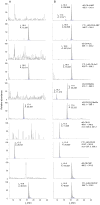DNA adduct formation of 4-aminobiphenyl and heterocyclic aromatic amines in human hepatocytes
- PMID: 21456541
- PMCID: PMC3118939
- DOI: 10.1021/tx200091y
DNA adduct formation of 4-aminobiphenyl and heterocyclic aromatic amines in human hepatocytes
Abstract
DNA adduct formation of the aromatic amine, 4-aminobiphenyl (4-ABP), a known human carcinogen present in tobacco smoke, and the heterocyclic aromatic amines (HAAs), 2-amino-9H-pyrido[2,3-b]indole (AαC), 2-amino-1-methyl-6-phenylimidazo[4,5-b]pyridine (PhIP), 2-amino-3-methylimidazo[4,5-f]quinoline (IQ), and 2-amino-3,8-dimethylmidazo[4,5-f]quinoxaline (MeIQx), potential human carcinogens, which are also present in tobacco smoke or formed during the high-temperature cooking of meats, was investigated in freshly cultured human hepatocytes. The carcinogens (10 μM) were incubated with hepatocytes derived from eight different donors for time periods up to 24 h. The DNA adducts were quantified by liquid chromatography-electrospray ionization mass spectrometry with a linear quadrupole ion trap mass spectrometer. The principal DNA adducts formed for all of the carcinogens were N-(deoxyguanosin-8-yl) (dG-C8) adducts. The levels of adducts ranged from 3.4 to 140 adducts per 10(7) DNA bases. The highest level of adduct formation occurred with AαC, followed by 4-ABP, then by PhIP, MeIQx, and IQ. Human hepatocytes formed dG-C8-HAA-adducts at levels that were up to 100-fold greater than the amounts of adducts produced in rat hepatocytes. In contrast to HAA adducts, the levels of dG-C8-4-ABP adduct formation were similar in human and rat hepatocytes. These DNA binding data demonstrate that the rat, an animal model that is used for carcinogenesis bioassays, significantly underestimates the potential hepatic genotoxicity of HAAs in humans. The high level of DNA adducts formed by AαC, a carcinogen produced in tobacco smoke at levels that are up to 100-fold higher than the amounts of 4-ABP, is noteworthy. The possible causal role of AαC in tobacco-associated cancers warrants investigation.
Figures







Similar articles
-
DNA adducts of the tobacco carcinogens 2-amino-9H-pyrido[2,3-b]indole and 4-aminobiphenyl are formed at environmental exposure levels and persist in human hepatocytes.Chem Res Toxicol. 2013 Sep 16;26(9):1367-77. doi: 10.1021/tx4002226. Epub 2013 Aug 16. Chem Res Toxicol. 2013. PMID: 23898916 Free PMC article.
-
Bioactivation of the tobacco carcinogens 4-aminobiphenyl (4-ABP) and 2-amino-9H-pyrido[2,3-b]indole (AαC) in human bladder RT4 cells.Arch Toxicol. 2019 Jul;93(7):1893-1902. doi: 10.1007/s00204-019-02486-7. Epub 2019 Jun 15. Arch Toxicol. 2019. PMID: 31203411 Free PMC article.
-
Biomonitoring DNA Adducts of Cooked Meat Carcinogens in Human Prostate by Nano Liquid Chromatography-High Resolution Tandem Mass Spectrometry: Identification of 2-Amino-1-methyl-6-phenylimidazo[4,5-b]pyridine DNA Adduct.Anal Chem. 2016 Dec 20;88(24):12508-12515. doi: 10.1021/acs.analchem.6b04157. Epub 2016 Dec 1. Anal Chem. 2016. PMID: 28139123 Free PMC article.
-
Biological significance of trace levels of mutagenic heterocyclic aromatic amines in human diet: a critical review.Food Chem Toxicol. 1994 Oct;32(10):977-94. doi: 10.1016/0278-6915(94)90093-0. Food Chem Toxicol. 1994. PMID: 7959450 Review.
-
Mammary gland carcinogenesis by food-derived heterocyclic amines and studies on the mechanisms of carcinogenesis of 2-amino-1-methyl-6-phenylimidazo[4,5-b]pyridine (PhIP).Mutat Res. 2002 Sep 30;506-507:145-52. doi: 10.1016/s0027-5107(02)00161-6. Mutat Res. 2002. PMID: 12351154 Review.
Cited by
-
The analysis of DNA adducts: the transition from (32)P-postlabeling to mass spectrometry.Cancer Lett. 2013 Jun 28;334(1):10-9. doi: 10.1016/j.canlet.2012.08.007. Epub 2012 Sep 4. Cancer Lett. 2013. PMID: 22960573 Free PMC article. Review.
-
Mass Spectrometric Characterization of Human Serum Albumin Adducts Formed with N-Oxidized Metabolites of 2-Amino-1-methylphenylimidazo[4,5-b]pyridine in Human Plasma and Hepatocytes.Chem Res Toxicol. 2015 May 18;28(5):1045-59. doi: 10.1021/acs.chemrestox.5b00075. Epub 2015 Apr 10. Chem Res Toxicol. 2015. PMID: 25815793 Free PMC article.
-
Metabolic Activation of the Cooked Meat Carcinogen 2-Amino-1-Methyl-6-Phenylimidazo[4,5-b]Pyridine in Human Prostate.Toxicol Sci. 2018 Jun 1;163(2):543-556. doi: 10.1093/toxsci/kfy060. Toxicol Sci. 2018. PMID: 29596660 Free PMC article.
-
Metabolism of the Tobacco Carcinogen 2-Amino-9H-pyrido[2,3-b]indole (AαC) in Primary Human Hepatocytes.Chem Res Toxicol. 2017 Feb 20;30(2):657-668. doi: 10.1021/acs.chemrestox.6b00394. Epub 2016 Dec 15. Chem Res Toxicol. 2017. PMID: 27976871 Free PMC article.
-
Base-displaced intercalation of the 2-amino-3-methylimidazo[4,5-f]quinolone N2-dG adduct in the NarI DNA recognition sequence.Nucleic Acids Res. 2014 Mar;42(5):3450-63. doi: 10.1093/nar/gkt1109. Epub 2013 Dec 23. Nucleic Acids Res. 2014. PMID: 24366876 Free PMC article.
References
-
- Clayson DB. Specific aromatic amines as occupational bladder carcinogens. Natl Cancer Inst Monogr. 1981:15–19. - PubMed
-
- IARC. Tobacco smoking. Vol. 38. International Agency for Research on Cancer; 1986. Monographs on the Evaluation of Carcinogenic Risks to Humans.
-
- International Agency for Research on Cancer. Overall evaluation of carcinogenicity: An updating of IARC monographs 1–42. IARC Monographs on the Evaluation of Carcinogenic Risks to Humans. 1987;7(suppl) - PubMed
-
- Stavric B, Klassen R, Miles W. Gas-liquid chromatographic-mass spectrometric determination of alpha- and beta-naphthylamines in FD&C Red No. 2 (amaranth) J Assoc Off Anal Chem. 1979;62:1020–1026. - PubMed
-
- Davis VM, Bailey JE., Jr Chemical reduction of FD&C yellow No. 5 to determine combined benzidine. J Chromatogr. 1993;635:160–164. - PubMed
Publication types
MeSH terms
Substances
Grants and funding
LinkOut - more resources
Full Text Sources
Miscellaneous

